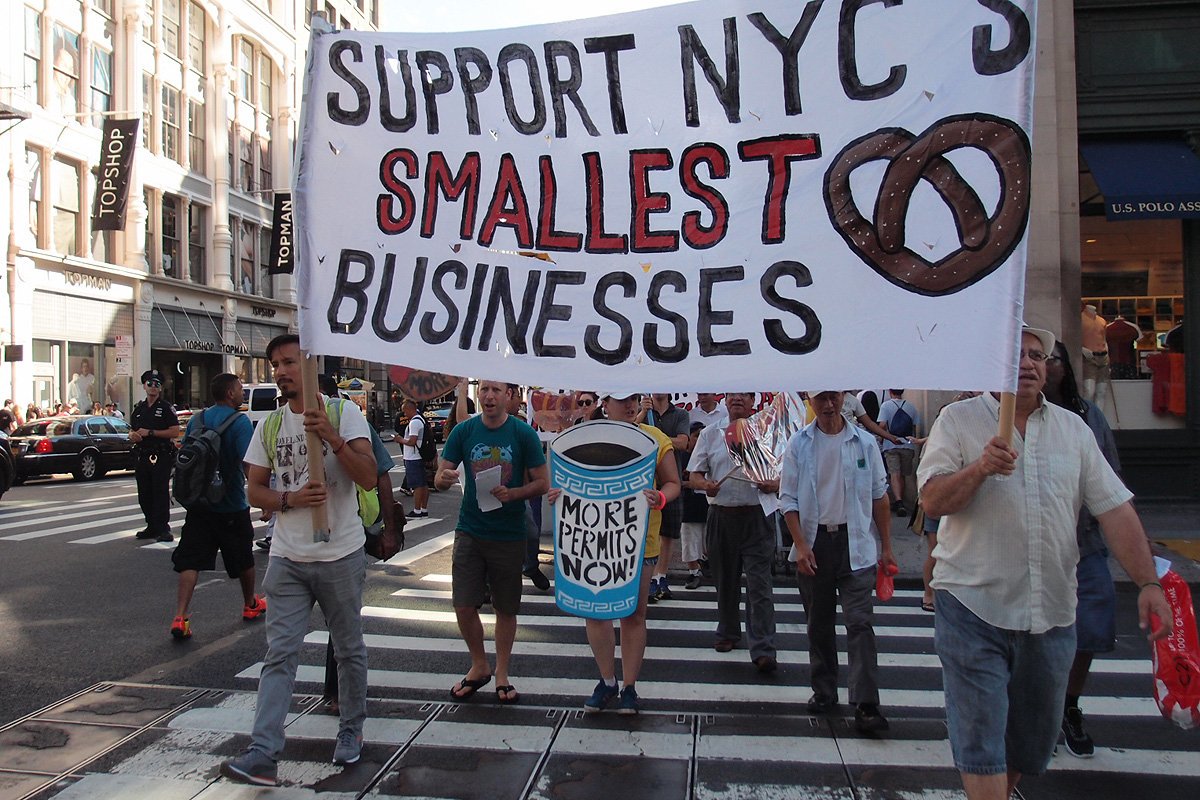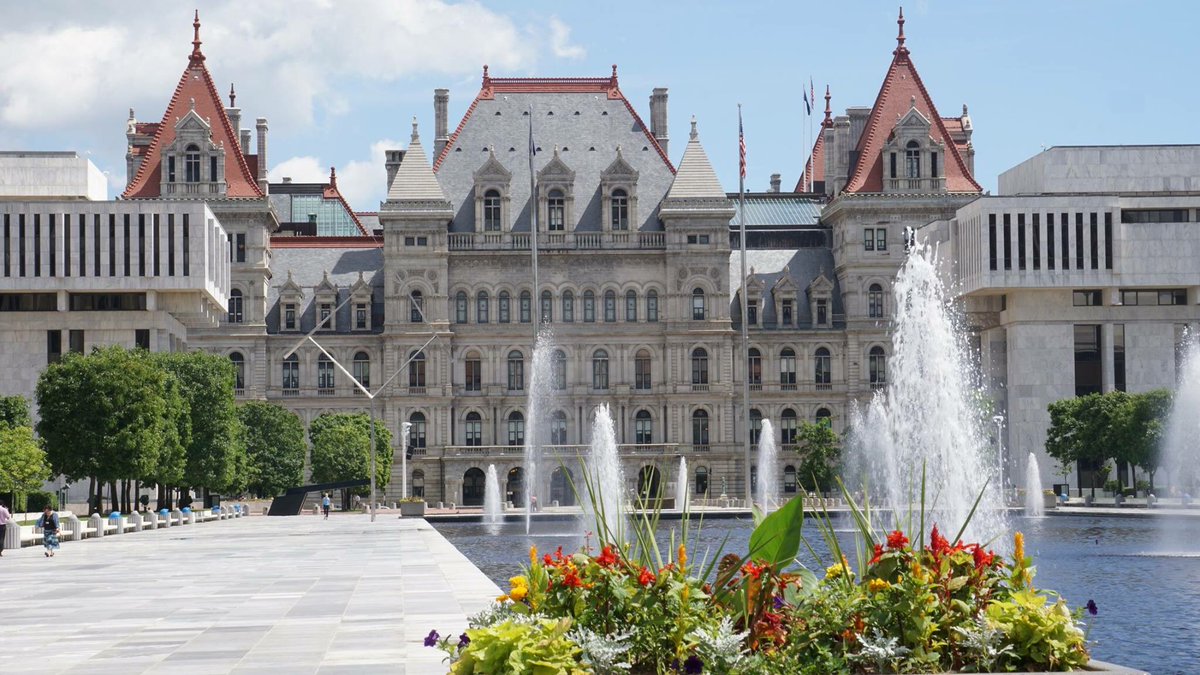How the City Hurts Small Businesses

Street vendors protest the city's cap on permits (photo: @VendorPower)
Independent small businesses -- bodegas, pizza joints, shoe repair shops, fruit vendors -- are the heart and soul of New York City. But they are facing a crisis. Every day there is another story about some beloved neighborhood shop closing due to skyrocketing rents. Landlords then warehouse the vacant spaces in hopes of signing a lease with a bank or big chain. WNYC recently counted 17 vacancies on just two blocks of Christopher Street. And a report by the Manhattan Borough President found almost 200 shuttered storefronts on Broadway alone.
What is Mayor de Blasio doing to fix this problem? Nothing.
When asked about it -- and he frequently is -- the mayor claims the government’s hands are tied because the “free enterprise” system alone controls what landlords do with their space. The mayor had no real comment on a package of reforms unveiled last week by USBnyc, a new citywide coalition of small business owners, most of them immigrant-owned. And a couple months ago, speaking to Tony Danza, actor and owner of a 125-year-old cheese shop in Little Italy, the mayor’s only solution to the problem was to “urge the landlords to be less greedy.” Good luck with that!
But, in fact, the city is not a passive observer - it actively supports large landlords to the detriment of small business owners. For years, the main priority of the city’s Department of Small Business Services has not been to help mom and pops, but to organize and support Business Improvement Districts, the somewhat mysterious, quasi-public organizations that exist across the city, from Montague Street in Brooklyn to Melrose in the Bronx, with more being created each year.
SBS spends more of its yearly budget fostering BIDs (what it calls “neighborhood development”) than it does supporting actual small businesses. Just last month, the city doled out $500,000 for BIDs to create mobile technology apps. And all that is apart from the millions in funding that BIDs receive each year from the City Council.
The BIDS have innocuous-sounding names like the 82nd Street Partnership and the Village Alliance. Their glossy annual reports invariably show smiling shopkeepers and kids frolicking in fountains. Usually they are structured to give some minority of votes to local commercial tenants or residents. But make no mistake: by law, BIDs are controlled by commercial real estate landlords. Their mission is to maximize the cash flow they receive from their valuable investments. If that means kicking out a 50-year-old beauty supply shop to replace it with an artisanal gelato chain, too bad. As Mayor de Blasio would say, that’s capitalism at work.
It’s true that New York neighborhoods are always in flux, and too much nostalgia can be dangerous. But it wasn’t always like this. BIDs have only existed in New York for about 30 years, since the Union Square Partnership was founded in 1984. With the city in financial distress, landlords sought permission to tax themselves to provide basic services, like sanitation and security, where the city was falling short. Who could refuse such an offer? Even as the city rebounded during the Giuliani and Bloomberg eras, the city pushed for BID expansion, boosting their number to 44 in 2002 and 73 today. And the trend continues under Mayor de Blasio, who blessed new BIDs in Springfield Gardens, Queens and New Dorp, on Staten Island.
But BIDs don’t just power-wash sidewalks and post security guards on the corner. They play an active role to advance the interests of real estate owners in shaping public policy. They attend Community Board meetings, hire lobbyists, and nurture relationships with elected officials. With a collective budget in the hundreds of millions, they have a powerful voice. For years, together with the Real Estate Board of New York, they have blocked the Small Business Jobs Survival Act, which would require landlords to sit down and talk with their commercial tenants before doubling or tripling their rent.
And, so far, the BIDs have stalled the Street Vendor Modernization Act. In October, no less than a dozen BID managers personally testified against the vending reform package in City Council chambers, while their lobbyists shook hands with officials in the hallway.
Everyone, of course, has a right to testify. But it’s time to have a public discussion about whether, as some have suggested, BIDs have outlived their usefulness. New Yorkers today are concerned about gentrification, not “white flight.” It’s time for a neutral study of whether BIDs lead to unfair distribution of basic services and the privatization of public space. And time to ask Mayor de Blasio why, if he cares about mom and pop small business owners, his administration continues to tip the scales in favor of the very same real estate companies that are driving them out.
***
Sean Basinski is director of the Street Vendor Project at the Urban Justice Center. On Twitter @SeanBasinski.
***
Have an op-ed idea or submission for Gotham Gazette? Email This email address is being protected from spambots. You need JavaScript enabled to view it.
What’s a Constitutional Convention Cost? We Can’t Afford to Not Hold One

the Capitol, via @NYSCapitolVisit
When asked what a state constitutional convention might cost if called by voters in 2017, I said at a State Bar Association panel event that I had applied the Bureau of Labor Statistics CPI inflator to what I then thought was the 1967 convention’s cost and got $47 million. Casey Seiler of the Albany Times Union was there. He did not hear or realize that I had adjusted for inflation, so he used the $47 million figure as the cost of the 1967 convention. This led others to then adjust for inflation based on that number, leading to the proliferation of a faulty projected cost of $350 million, immediately seized upon by convention opponents. (Seiler later published a correction.)
The Public Employees Federation wrote: “Experts estimate a constitutional convention would cost hundreds of millions of dollars.” Senator Majority Leader John Flanagan used it as evidence that a convention would be outrageously expensive, with no “guarantee” of any positive result. The wildly wrong number repeatedly popped up in media outlets all over the state. Even after shown the error of their ways in debates, opponents were loath to give up this ‘alternative fact.’ All of this was chronicled by Bill Mahoney as an urban legend in Politico New York.
Since then a leading convention advocate, Chris Bopst, went back to the state comptroller’s actual spending records. He found that between 1967 and 1971 a total of $7,580,885 was spent on preparing for and conducting the last constitutional convention. Of this, $527,051 ($3,977,673 in 2017 dollars) was for a preparatory commission. We haven’t had one of those this time; the Legislature killed it. This leaves $7,053,834, spent over a total of four years. In 2017 dollars this is $51,448,160, not far off (8.6%) from my original more-or-less shot in the dark of $47 million.
There’s no telling if the cost of the 1967 convention is a good guide for what a convention would cost if held today. After all, 1967 was half a century ago. (It’s the longest time since a constitutional convention was held in New York State history.) Some say that a better estimate is this year’s budget for the Legislature’s larger house, the Assembly. That roughly doubles the number, bringing it to $105.4 million.
One big thing is being missed: a major expense of the convention, the cost for delegates’ pay, would likely be lower in real terms this time around. The reason? Each delegate must be paid the salary of an Assembly member, and legislative compensation has gone up since 1967 far more slowly than the rate of inflation.
In 1967 there were 186 delegates; each was paid $15,000. Total delegate costs were therefore $2,790,000, just short of 40% of the convention’s overall cost. At the next convention, if it is authorized, there will be 204 delegates (three from each Senate district – there are now 63, not 57 – and 15 at large). Unless there is a legislative pay raise, each will earn $79,500. The total payroll for delegates will thus be $16,218,000. This is 29.8% of the current-dollar cost of the 1967 convention, and 15.4% of the 2017 Assembly budget.
At this potential level of cost, is a convention worth it? A comparison, albeit imperfect, suggests itself.
Successful businesses regularly reorganize, merge, or acquire companies to increase profitability by becoming more efficient, managing scale, and consolidating strengths. A close friend on Wall Street estimated the bankers’ costs of a $50 billion acquisition to be somewhere around .50% of enterprise value – lawyers of course are extra! The New York state budget is $153.1 billion. If we use $105 million as the high end constitutional convention cost – we arrive at a “reorganization “ cost that is .001% of the state’s annual budget.
Corporate reorganizations, mergers, and acquisitions are pursued because the benefits are expected to exceed the costs and to accrete over the long term. Not all benefits, of course, can be defined with a financial value. The gains a convention would likely produce in democratic accountability and good government are potentially enormous, but hard to monetize. However, think of this: One 2007 study estimated that a thorough reorganization of New York’s courts, sought for decades and recently said by the State Bar Association to be possible only through a constitutional convention, would save over $500 million ($600 million in 2017 dollars). That’s six times the high end cost of a convention in 2017.
What do these numbers tell us? It’s a no brainer. We cannot afford to not hold a constitutional convention.
***
Gerald Benjamin is director of The Benjamin Center at SUNY New Paltz.
***
Have an op-ed idea or submission for Gotham Gazette? Email This email address is being protected from spambots. You need JavaScript enabled to view it.
New York Must Lead on Civil Rights

(photo via @NYSEDNews)
The silence from D.C. is deafening.
As The Washington Post recently reported, “the Trump administration is reducing the role of the federal government in fighting discrimination and protecting minorities by cutting budgets, dissolving programs and appointing officials unsympathetic to previous practices.”
Earlier this month, U.S. Education Secretary Betsy DeVos testified that “this department is not going to be issuing decrees” on major civil rights issues – even though interpreting and enforcing civil rights law is, in fact, the role of the agency she leads.
And Secretary DeVos’ agency then announced major changes that will dramatically weaken civil rights enforcement.
This lack of national leadership is shameful. But if the federal government is going to devolve its historic role protecting civil rights to the states, New York is well-positioned to be a beacon for the nation at a time when our students need it the most.
Building on significant work already underway by state leaders, there are three additional steps that New York should take.
First, New York must modernize its laws to protect students who are the victims of discrimination. Due to a court decision in 2012, the state’s Division of Human Rights has only been allowed to enforce anti-discrimination protections in private schools – not in public K-12 schools or public colleges and universities. These anti-discrimination protections should be immediately extended to all students in all public schools.
In fact, legislation has already been endorsed by Governor Cuomo and passed the Assembly. All that’s standing in the way of protecting students is a vote by the State Senate. The federal government’s abrogation of its duty to protect students should give new impetus to legislators from both parties to vote. When the Legislature returns in January, this bill deserves an immediate vote.
But there’s more the state can do right now.
Government also has a broader responsibility to set standards, investigate systemic disparities and enforce civil rights protections. The U.S. Department of Education could previously be counted on to issue guidelines specifying how federal laws and regulations should be interpreted, and then monitor and report on whether they are being properly implemented. Under President Obama, for example, guidelines were used to protect transgender students and to demand that colleges prevent and address sexual violence.
Not anymore. The federal guidelines protecting transgender students have already been rescinded, and the Office of Civil Rights’ budget would be decimated under the current president’s proposal. Where the federal government is newly silent, New York should take up the mantle on behalf of students. The Attorney General’s Office and State Education Department have already shown clear leadership – for example, protecting immigrant students and transgender students and committing resources and staff to monitor school districts – as has the Governor’s Office on issues including college sexual assault.
These three state offices should now work together to take additional steps to fill the federal vacuum – issuing or strengthening guidelines, conducting investigations, and publicly reporting on their findings. For example, disparities in access to college-prep coursework and the disproportionate use of exclusionary discipline such as suspensions are two issues ripe for greater focus from a civil rights perspective. And LGBT students, immigrant students, students with disabilities, and victims of sexual violence are only a few of the groups that would benefit from a sustained civil rights presence.
In addition, individuals and advocates have counted on the ability to file civil rights complaints with sympathetic U.S. Departments of Education and Justice. Since those federal agencies now can’t be counted on to stand up for students, the state needs to bulk up its enforcement mechanisms.
These important functions will no doubt require additional resources – an important reason that the state should plan now.
Finally, data is often what makes it possible to identify patterns of systemic injustice. The U.S. Department of Education’s Office of Civil Rights operates a rich source of data on educational inequities called the Civil Rights Data Collection. These data shine a light on critical issues like access to college-prep courses, student discipline measures, and school staffing.
The State Education Department should commit to maintain this data collection (regardless of whether the federal government continues to require it), validate New York’s data so that it is accurate and actionable, and put it to use through standardized reporting and public tools. Acting now will send an important signal to school districts and provide time to request any additional resources needed to carry out these data integrity and dissemination functions.
Because if the federal government is going to abandon the students most at risk, we should be able to count on New York stepping up in their defense.
***
Ian Rosenblum is the executive director of The Education Trust—New York. On Twitter @ianrosenblum & @EdTrustNY.
***
Have an op-ed idea or submission for Gotham Gazette? Email This email address is being protected from spambots. You need JavaScript enabled to view it.




